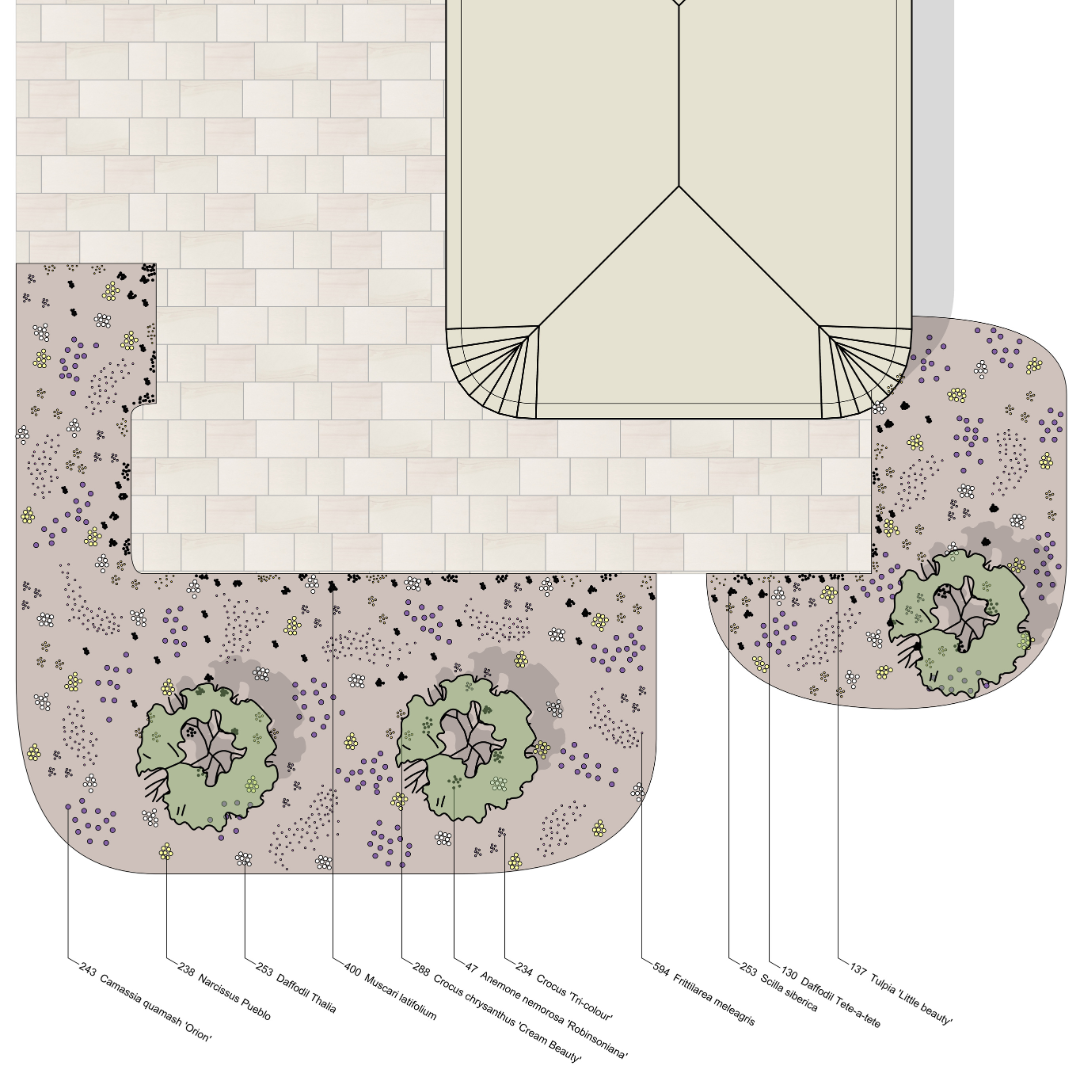We recently completed a naturalistic bulb planting design for a client’s front garden. The area can be damp and is a little shaded in places. We aimed to create a naturalistic display that provides colour from early spring through to late May. In total we planted nealy 3000 bulbs. The planting includes a mix of early crocus and daffodils, followed by later-flowering tulips, camassia, and fritillaria to extend the season and provide a succession of colour.
Here’s what went into the design:
Early Spring (February – March)
- Scilla siberica (250 bulbs) – Electric blue flowers that pop up in February to March, creating a striking carpet beneath deciduous shrubs. These bulbs are incredibly hardy and will slowly spread, forming a stunning blue haze in early spring. They work beautifully in combination with other early bloomers like crocus and daffodils.
- Crocus ‘Tricolour’ (250 bulbs) – A cheerful little crocus with purple, white, and yellow banding, one of the first signs of spring. It thrives in well-drained soil and is perfect for naturalising in grass or borders. Its striking colours create a wonderful contrast in mixed plantings.
- Crocus ‘Cream Beauty’ (500 bulbs) – A soft yellow crocus that naturalises well and pairs beautifully with ‘Tricolour’. It forms dense clusters of flowers, providing much-needed nectar for early pollinators. The soft, buttery tones add warmth to the early spring garden.
- Anemone nemorosa ‘Robinsoniana’ (75 bulbs) – A delicate woodland anemone with soft lilac-blue flowers, spreading gently over time. It prefers partial shade and moist soil, making it an excellent choice for underplanting trees and shrubs. Flowers from March to April. The dainty blooms create a carpet effect, enhancing woodland-style gardens.
Mid-Spring (March – April)
- Muscari armeniacum (250 bulbs) – Deep blue grape hyacinths that add contrast and texture among the daffodils, flowering from March to April. Their tightly packed, bell-shaped flowers are loved by bees and provide a strong, long-lasting burst of colour. When planted en masse, they create a sea of vibrant blue.
- Daffodil ‘Tete-a-Tete’ (250 bulbs) – A classic miniature daffodil, bright and reliable, flowering from February to March. Its compact size makes it perfect for pots, rock gardens, and front-of-border plantings. This variety is known for its resilience and ability to withstand spring storms.
- Daffodil ‘Thalia’ (250 bulbs) – An elegant, multi-headed white narcissus that brings a refined touch. Flowers in April. It has a sweet fragrance and works beautifully in drifts or mixed borders for a delicate, airy effect. Its white petals glow in the evening light, making it an excellent choice for moon gardens.
Mid-Spring (March – April)
- Muscari armeniacum (250 bulbs) – Deep blue grape hyacinths that add contrast and texture among the daffodils, flowering from March to April. Their tightly packed, bell-shaped flowers are loved by bees and provide a strong, long-lasting burst of colour. When planted en masse, they create a sea of vibrant blue.
- Daffodil ‘Tete-a-Tete’ (250 bulbs) – A classic miniature daffodil, bright and reliable, flowering from February to March. Its compact size makes it perfect for pots, rock gardens, and front-of-border plantings. This variety is known for its resilience and ability to withstand spring storms.
- Daffodil ‘Thalia’ (250 bulbs) – An elegant, multi-headed white narcissus that brings a refined touch. Flowers in April. It has a sweet fragrance and works beautifully in drifts or mixed borders for a delicate, airy effect. Its white petals glow in the evening light, making it an excellent choice for moon gardens.
Late Spring (April – May)
- Tulip ‘Little Beauty’ (200 bulbs) – A striking, low-growing tulip with pink and blue flowers, great for adding a splash of late-season colour. Flowers in April. This tulip is perfect for rockeries and naturalistic plantings, opening wide in full sun to reveal its vivid centre. Its compact size makes it ideal for small gardens and containers.
- Fritillaria meleagris (594 bulbs) – Snake’s head fritillary, with its beautiful chequered purple and white flowers, perfect for naturalising in dappled shade. Flowers from March to April. These unique blooms thrive in damp soils and meadows, adding a touch of the wild to any planting scheme. They are particularly well-suited to areas that mimic their native floodplain habitats.
- Camassia quamash ‘Orion’ (243 bulbs) – A later-flowering bulb with tall spires of violet-blue flowers, great for pollinators. Flowers from May to June. Camassia is ideal for heavy soils and damp meadows, where it stands tall, waving gracefully in the breeze. Its architectural presence makes it an excellent addition to prairie-style plantings.
The bulbs were laid out in natural drifts, ensuring they blend seamlessly into the garden. Over time, many of these will multiply, creating an ever-improving display each spring.
This project was a pleasure to work on, and I’m excited to see how the garden transforms over the coming seasons!



Leave a Reply